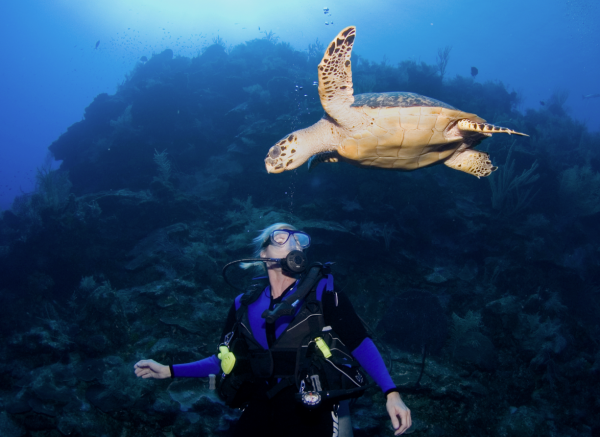 For a better experience on Ocean Frontiers, Update Your Browser.
For a better experience on Ocean Frontiers, Update Your Browser. Sea Turtles: Protecting the Beloved Symbol of the Cayman Islands
- Stephen Broadbelt
- October 16th 2013

- Nesting season highlights the need to protect sea turtles now and focuses the community’s attention on what needs to be done for the future.
- An encounter with a sea turtle is always high on the wish list of every visiting diver to the Cayman Islands, and they are very rarely disappointed. The sea creature recognized as the national symbol of the Cayman Islands almost always makes an appearance during a dive, sometimes more than once, fulfilling expectations of any dive enthusiast.
- Cayman waters have a relatively healthy population of hawksbill and the green turtles, and local divemasters say they can count on spotting at least one sea turtle per dive to keep guests happy. Sometimes, as many as four turtles swim by to check out the excited divers.
- “Close encounters with turtles big or small always put a smile on our diver’s faces,” says Ocean Frontiers Divemaster 'The Hobbit'. “As divemasters we urge our divers to enjoy their turtle interactions passively- no chasing, and definitely no touching!”
- Turtles are iconic in the Cayman Islands, and they have played a significant role in the history of these islands. During sea turtle nesting season, May – November, the local community’s focus turns to protecting the beloved creatures. The Cayman Islands Department of Environment manages an effective turtle-nesting program that raises awareness and continually educates the public on what needs to be done to protect them.
- Historically, four types of sea turtles were found in Cayman waters - green, loggerhead, hawksbill and leatherback turtles. It is believed millions of green turtles nested here, the largest number in the Atlantic. Christopher Columbus, who discovered the islands in 1503, called them “Las Tortugas” because of the abundant sea turtles. Commercial harvesting decimated the turtle populations to the point of extinction, but they have gradually made a comeback. In 1998, the Cayman Islands Department of Environment began surveying beaches to identify turtle nests and track the nesting season.
- “The first years of monitoring showed that leatherback nesting was indeed locally extinct, and likely lost to us forever, but extremely small numbers of green, loggerhead, and hawksbill turtles persisted,” says Research Officer Dr. Janice Blumenthal. “Since that time, hawksbill nesting has continued to hover at the edge of extinction but loggerhead and particularly green turtle populations have begun to show signs of recovery – increasing from less than 30 nests when DOE monitoring began in 1998 to 275 nests this year.”
- Dr. Blumental says they were encouraged to document several hawksbill turtle nests this year, but they have yet to see leatherbacks make a return. The DOE and Cayman’s dive operators have helped garnered support from many residential condo complexes and resorts to use low wattage lights, or turn off lights during the nesting season. Low season turtle eco-tourism has developed – a direct result of properties taking part in protecting the nests and improving survival chances for the hatchlings. When the nests start hatching, turtle events bring people out to cheer the hatchlings on as they begin their dangerous journey to the sea. Mysteriously, the females who survive into adulthood will some day return to nest on the same beach where they were born.
- While sea turtles have made a comeback in Cayman, the overall worldwide population of sea turtles is either endangered or threatened. The biggest threat to them is trash in the ocean - fishing line and plastic bags kill countless each year. Development threatens the beaches where turtles lay their eggs and light pollution disorients the hatchlings that often end up on dangerous roads instead of the sea. Dr. Janice Blumenthal says it is important to understand that sea turtles need protection everywhere, all the time.
- “Because they are highly migratory, sea turtles face threats throughout their life-cycle – on the nesting beach (as eggs, hatchlings, and adults), in the open ocean, and on their feeding grounds here in the Cayman Islands,” she says. “Our management decisions in Cayman will affect turtle populations in other parts of the world – and our turtles are threatened by the actions of distant countries. If we are to protect our turtles, we must remember that they are a shared Caribbean Heritage.”
Comment form
User Comment(s)
Total Comment(s): 0
No Comment(s) Founds

